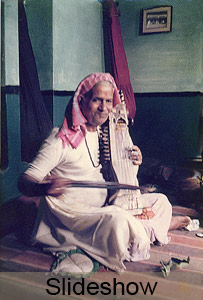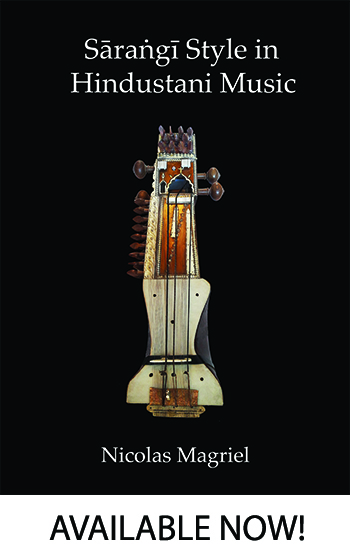
Born in 1914, Pandit Hanuman Prasad Mishra is one of the two most senior functional sarangi players on this website. In 1971, after learning from Hanumanji's illustrious younger brother Pandit Gopal Mishra in Delhi for a short while, I moved to Banaras, not being able to cope with the hustle and bustle and alienation of Delhi life. I learned from Pandit Hanuman Prasad Mishra (1913-1999) for more than three years, and learned a lot about patience and about how things work in traditional musical society. But he taught me almost nothing about music or about sarangi technique, apart from a handful of beautiful bandishes (songs) which I still play and sing. He was a wonderful flamboyant character, one of the last master musicians of Banaras. I continued to visit him whenever I was in Banaras throughout the 80s and 90s, enjoying his endearing rustic style of being and music-making. He was a true rasika.
Hanuman Prasad Mishra was the son and student of Sur Sahai Mishra, one of the great historical musical figures of Kabir Chaura, Banaras. He also learned vocal music from the legendary vocalist Bara Ram Das. And he was the father and teacher of the world-famous singing duo Pandits Rajan and Sajan Mishra.
Hanumanji is also said to have been largely responible for teaching Gopal Mishra who was fifteen years younger. Unlike his younger brother, Hanumanji was not crazy about practice—and so not too concerned about mainaining his instrument. But although his playing was sometimes a little rough, he had an extraordinary subtlety and delicacy and an incredible sense of tonal balance especially when playing Banaras semi-classical specialties—thumri, dadra, chaiti purvi, kajri and jhoola. He was also a superb singer of these styles and also of pure khayal.
See the bottom of the page for a wonderful selection of audio recordings of Hanumanji.
Here I offer several videos of his performances including a concert I arranged at Amar Bhavan, Banaras, a midnight recording session at a Christian monastary in Christ Ganj outside Banaras, and a singing performance in the home of Bhola Nath Mishra in Kabir Chaura, Banaras.When I get around to uploading videos from 1997, you will have the pleasure of watching Hanumanji counting and sorting an impressive quantity of banknotes, surrounded by flowers, sweets and other offerings from students on the occasion of Saraswati Puja (celebrating the Goddess of music and learning). He was truly, to use Joep Bor's epithet the grand old man of the sarangi!
NOTE: at the bottom of the page, you will find several audio recordings of Hanumanji.
We begin with the concert at Amar Bhavan—Christmas day 1993. Guruji's first offering was rag Yaman. He begins by carefully wrapping his fingers in strips of cotton sheeting:
This was followed by rag Jog.
After a beautifully sensual hori, Hanumanji delights in A Long Way to Tipperary, demonstrating his au faitness with Western culture. He tells us an entertaining story about playing this song in the days of the British Raj.
Next we have a delicious chaiti, one of the semi-classical delights of Banaras, celebrating Springtime prematurely.
The programme concluded with a lovely dadra.
Hanumanji spoke of music, especially thumri, as being a "motiya ka mala", a garland of pearls. Our next series of videos is truly a motiya ka mala. This was a recording session organised by Lyle Wachovsky at a recording studio in a Christian Monastary, Christ Ganj, around 15 miles outside Banaras. It was a freezing winter and Hanumanji was 82-years old. He wasn't playing at all those days—his hands were bundled up in thick woolen gloves. But Lyle offered an unheard of amount of money for recording, and the gloves came off patapat. There were all sorts of delays because it was raining, and we didn't get to the studio until around midnight, and there were other people to record also—Baccha Lal Mishra and the sitarist Amar Nath Mishra. But Hananumanji had a good supply of paan and stayed awake. His sarangi playing was rough, but to my ears, beautiful as always. Lyle was in a furious sweat, tearing his hair out, and wanted to abandon the recording, but I pressurised him—this was a matter of izat—respect. "You don't get an 82-rear old highly-respected musicians out into the jungle in the middle of the night and send him home without doing the work he came to do". I had in fact introduced Lyle to Hanumanji, but had warned him that Hanumanji wasn't in practice and told him that, however much I personally loved it, in my opinion Hanumanji's playing would not meet the stringent requirements of Lyle's type of CD recording, but Lyle had ignored this advice.
Anyway the recording went on, and Hanumanji played two of each item—one for preparation and one for a final take. Ishwarlal Mishra accompanied him on tabla. Unusually, Hanumanji decided not to play khayal first but said he would just present "Banaras ki kaas chize", the semi-classical specialties of Banaras.These included rare genres such as daf hori and purvi. The CD was never released, but the recordings are very precious. Many years ago I memorised the entire hori in Kafi—which I'd transcribed for my PhD thesis.
Ten people bundled into a taxi—by the time we reached Chrit Ganj , everyone was somewhat worse for wear. I, for my part, forgot to turn off the counter on the video camera. But these pieces are of such profound archival value and embody such a heart-felt spiritual sensuality, that it really doesn't matter—like the sky blue and yellow walls.
The first piece is a Pilu thumri:
<
Then a bol banao-style hori in Kafi:
Then another version of the Kafi hori:
Then a daf hori:
Then a chaiti:
Hanumanji went into discursive mode talking about the rags Lalit, Lalita Gauri, and Chaita Gauri.
Then a purvi (not to be confused with the rag Purvi):
Then a chaiti-like dhun:
-
Then a kajri:
And the recording concluded with a Bhairavi thumri:
The next series is a rare and wonderful offering. Hanuman Prasad Mishra was also an accomplished and extremely knowlegable vocalist. His tradition is being carried on by his world-famous sons, Rajan and Sajan Mishra. Here we have a singing concert on February 8, 1994 in the temple of Bhola Nath Mishra's house in Kabir Chaura, Banaras. Baccha Lal Mishra accompanied Hanumanji on sarangi, and Bhola Nath Mishra accompanied on tabla. This performance is prime evidence of the profound command of vocal music enjoyed by the sarangiyas of yore. It was a cold winter night, and Hanumanji kept his gloves on. We begin with preparations and tuning:
The first piece was a full khayal performance in rag Chandrakauns:
Then Hanuman Mishra treated us to a rare tap-khayal in rag Chayanath:
This was followed by a tappa:
And then a thumri:
Then a beautiful bhajan:
And finally another beautiful bhajan and some wonderful talking:
Now a very precious jewel, a film about Hanumanji teaching his sons Rajan and Sajan Mishra, circa 1978, extraordinary profound talim of the highest orde:
Note that the last offering was not my film and I have no idea who made it or where I got it from—I would be grateful for any information about the provenance of this footage.
The next four videos are from the famous Sankat Mochan music festival in Banaras—April 1997. LAST OFFERING OF 2015!
Rag Shri:
A Chaiti:
A Gato:
Pilu dadra and gat:
AUDIO OF HANUMAN PRASAD MISHRA
The following player contains some real gems of Hanumanji's quintessentially delicate and passionately expressive Purab-ang sarangi style.


